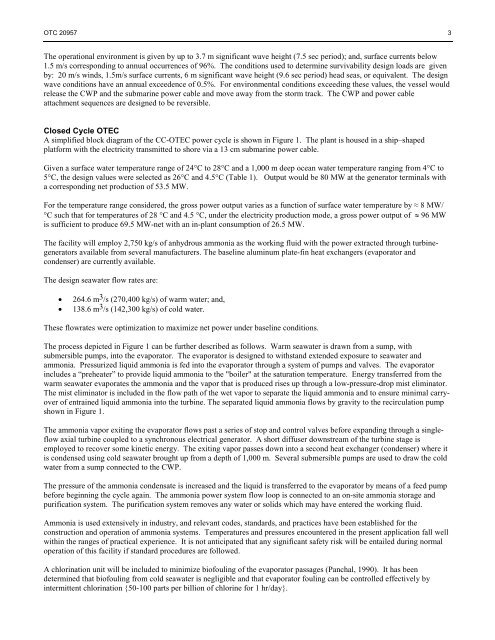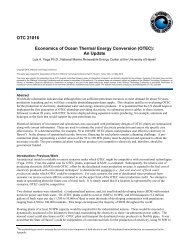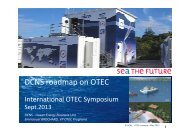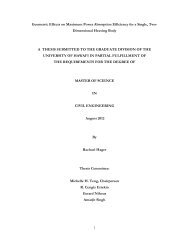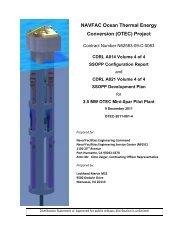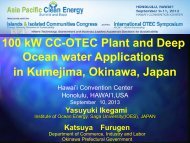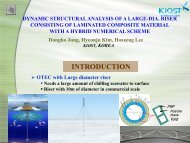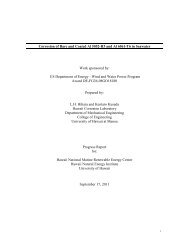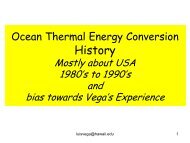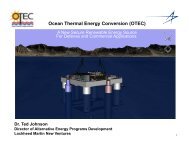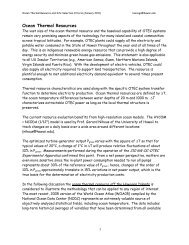50 MW OTEC Plantship Design - Hawaii National Marine ...
50 MW OTEC Plantship Design - Hawaii National Marine ...
50 MW OTEC Plantship Design - Hawaii National Marine ...
Create successful ePaper yourself
Turn your PDF publications into a flip-book with our unique Google optimized e-Paper software.
OTC 20957 3<br />
The operational environment is given by up to 3.7 m significant wave height (7.5 sec period); and, surface currents below<br />
1.5 m/s corresponding to annual occurrences of 96%. The conditions used to determine survivability design loads are given<br />
by: 20 m/s winds, 1.5m/s surface currents, 6 m significant wave height (9.6 sec period) head seas, or equivalent. The design<br />
wave conditions have an annual exceedence of 0.5%. For environmental conditions exceeding these values, the vessel would<br />
release the CWP and the submarine power cable and move away from the storm track. The CWP and power cable<br />
attachment sequences are designed to be reversible.<br />
Closed Cycle <strong>OTEC</strong><br />
A simplified block diagram of the CC-<strong>OTEC</strong> power cycle is shown in Figure 1. The plant is housed in a ship–shaped<br />
platform with the electricity transmitted to shore via a 13 cm submarine power cable.<br />
Given a surface water temperature range of 24°C to 28°C and a 1,000 m deep ocean water temperature ranging from 4°C to<br />
5°C, the design values were selected as 26°C and 4.5°C (Table 1). Output would be 80 <strong>MW</strong> at the generator terminals with<br />
a corresponding net production of 53.5 <strong>MW</strong>.<br />
For the temperature range considered, the gross power output varies as a function of surface water temperature by ≈ 8 <strong>MW</strong>/<br />
°C such that for temperatures of 28 °C and 4.5 °C, under the electricity production mode, a gross power output of ≈ 96 <strong>MW</strong><br />
is sufficient to produce 69.5 <strong>MW</strong>-net with an in-plant consumption of 26.5 <strong>MW</strong>.<br />
The facility will employ 2,7<strong>50</strong> kg/s of anhydrous ammonia as the working fluid with the power extracted through turbinegenerators<br />
available from several manufacturers. The baseline aluminum plate-fin heat exchangers (evaporator and<br />
condenser) are currently available.<br />
The design seawater flow rates are:<br />
• 264.6 m 3 /s (270,400 kg/s) of warm water; and,<br />
• 138.6 m 3 /s (142,300 kg/s) of cold water.<br />
These flowrates were optimization to maximize net power under baseline conditions.<br />
The process depicted in Figure 1 can be further described as follows. Warm seawater is drawn from a sump, with<br />
submersible pumps, into the evaporator. The evaporator is designed to withstand extended exposure to seawater and<br />
ammonia. Pressurized liquid ammonia is fed into the evaporator through a system of pumps and valves. The evaporator<br />
includes a “preheater” to provide liquid ammonia to the "boiler" at the saturation temperature. Energy transferred from the<br />
warm seawater evaporates the ammonia and the vapor that is produced rises up through a low-pressure-drop mist eliminator.<br />
The mist eliminator is included in the flow path of the wet vapor to separate the liquid ammonia and to ensure minimal carryover<br />
of entrained liquid ammonia into the turbine. The separated liquid ammonia flows by gravity to the recirculation pump<br />
shown in Figure 1.<br />
The ammonia vapor exiting the evaporator flows past a series of stop and control valves before expanding through a singleflow<br />
axial turbine coupled to a synchronous electrical generator. A short diffuser downstream of the turbine stage is<br />
employed to recover some kinetic energy. The exiting vapor passes down into a second heat exchanger (condenser) where it<br />
is condensed using cold seawater brought up from a depth of 1,000 m. Several submersible pumps are used to draw the cold<br />
water from a sump connected to the CWP.<br />
The pressure of the ammonia condensate is increased and the liquid is transferred to the evaporator by means of a feed pump<br />
before beginning the cycle again. The ammonia power system flow loop is connected to an on-site ammonia storage and<br />
purification system. The purification system removes any water or solids which may have entered the working fluid.<br />
Ammonia is used extensively in industry, and relevant codes, standards, and practices have been established for the<br />
construction and operation of ammonia systems. Temperatures and pressures encountered in the present application fall well<br />
within the ranges of practical experience. It is not anticipated that any significant safety risk will be entailed during normal<br />
operation of this facility if standard procedures are followed.<br />
A chlorination unit will be included to minimize biofouling of the evaporator passages (Panchal, 1990). It has been<br />
determined that biofouling from cold seawater is negligible and that evaporator fouling can be controlled effectively by<br />
intermittent chlorination {<strong>50</strong>-100 parts per billion of chlorine for 1 hr/day}.


